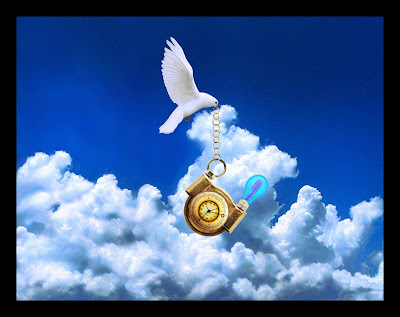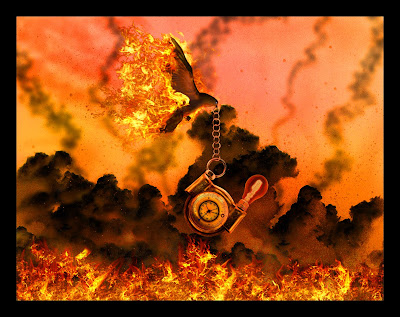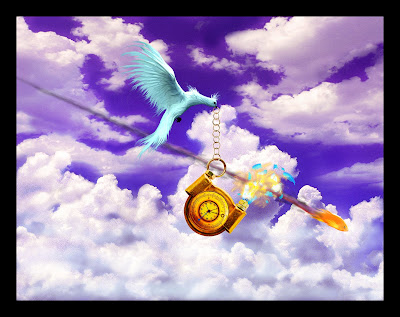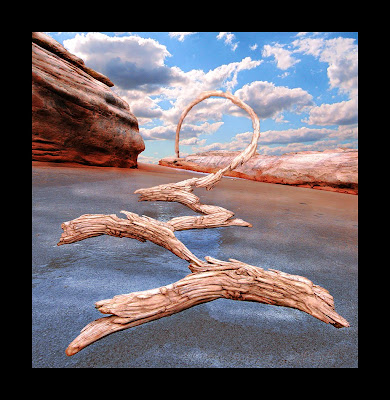Another day, another post.
The three pieces in this series were part of my Photoshop 2 class that I took in Spring 2009 at Lake Washington Technical College (LWTC). If you've paid attention to the math, you might realize that I took Photoshop 3 BEFORE Photoshop 2. I was given permission since I had TA'ed in my Photoshop 1 class a couple years back. Plus, it helped that the teacher knew me and knew that I enjoyed the challenge. Like my previous post and the last time I took a Photoshop class, the teacher was Bobbi Julag-Ay.

First I created the "ClockStop" from a mixture of a Stop Watch, Water Guage, Vice, and Lightbulb. After making the proper adjustments and image tweaks I then created the scene.
The clouds and sky were initially one image, perhaps a quarter of the size of the whole. I used the Clone Stamp and built up the clouds to give full image coverage. Next I brought in the dove and created the chain from the torus that was left over from the Stop Watch. After compiling the pieces I went through and made global enviromental adjustments such as lighting correction and proper levels adjustments to give the image the completed look you see above. I was aiming for a surreal and peaceful mood, which I why i enchanced the blues in the scene and kept the upper part of the sky clear; trying to latch on to and use the negative space to enchance the richness and purity of a clear sky.

This next image seems to be the one that most people like the most. Which is good, because I like it also. I wanted the image to be a polar opposite of the previous. So instead of peaceful and clear, I set it on fire! A good refreshing tactic when you're running low on ideas for a series.
I started by inverting the coloring of the dove, lightbulb, and clouds; then I went to go shop around. Where I see most people make final adjustments, assuming that an inverted color is enough, I used the Select Color Range and made my adjustments one screwed up looking level at a time with the usual suspects: Levels, Color Balance, and a cocktail of Adjustment Layers with all sorts of fun Layer Modes. After getting the coloring to a stage that I felt good about, I went crazy with the fire. Fire is difficult to place in a scene. I thought about bringing in some extra heat by lighting the base of many of the flames with plasma (as represented by the bluish/purple coloring you get near extremely hot sources) but decided against it when I realized it might throw off the focus of the piece.
So, after getting my fire to look more fire-like, I busted out the light smoke trail following the dove and some trails raising and dancing up from the flames below using some painting tools. I called it done at that point and about a day later came back and realized that it needed the speckling of ash to really drive the point home. I feel it worked out well. After that, it was a matter of pulling the piece together with global lighting and colors again.

Thus we reach the final iteration of the three part series. I had a hard time coming up with the concept. I wanted something distinctly different from the other two, maybe something abstract but still somewhat familiar - I decided on "other-worldly". And whats more other-worldly then a fish flying through the air like a bullet?
My first step, using the very first image as the base of course, was to change up the dove a bit. I did this with my trusty Smudge Tool as you may have guessed. After that, I took the lightbulb apart in chunks and made it's explosion. Then came the goldfish and it's smoke trail. It took a combination of painting then selections and a motion blur. Fairly straightforward.
After I had the elements in place, I made the color adjustments. Purple for the sky, greenish/blue for the dove (if you could call it a dove anymore), and I richened the Clockstop to a happy gold.
In the end I ended up really enjoying this project series.
 These images are renders (Maya 2009 using Mental Ray) from one of my first assignments in my Hard Surfaces and Organic Modeling class taught by the talented Adam Crespi. The model is of the Mitsubishi A6M1 Zero circa 1941 designed by Jiro Horikoshi for the Imperial Japanese Navy Air Service (IJNAS). For it's time, it was the best carrier-based fighter in the world.
These images are renders (Maya 2009 using Mental Ray) from one of my first assignments in my Hard Surfaces and Organic Modeling class taught by the talented Adam Crespi. The model is of the Mitsubishi A6M1 Zero circa 1941 designed by Jiro Horikoshi for the Imperial Japanese Navy Air Service (IJNAS). For it's time, it was the best carrier-based fighter in the world. I believe the main intent was to stress the importance of modeling to scale and to as exact a degree as you can. What this translates to is plugging in the actual scale figures when determining the dimensions of the polygonal shapes (boxes to begin with) then following blueprints of the contours and surfaces as observed in the front, top, and side views of the craft. We were encouraged to obtain plenty of reference of the craft in action to get a good understanding of how light settled along it: Thus helping to define exactly how each vertex and line should be placed.
I believe the main intent was to stress the importance of modeling to scale and to as exact a degree as you can. What this translates to is plugging in the actual scale figures when determining the dimensions of the polygonal shapes (boxes to begin with) then following blueprints of the contours and surfaces as observed in the front, top, and side views of the craft. We were encouraged to obtain plenty of reference of the craft in action to get a good understanding of how light settled along it: Thus helping to define exactly how each vertex and line should be placed. On the technical side of things, the focus was given to using the Insert Edge Loop tool. For those unfamiliar, it's purpose is to create lines and points along an object that can then be manipulated. A good example of what it does: taking a cylinder, inserting an Edge Loop near the top to form the bevel that you commonly see in pop cans; helping to define edges of the object. In drawing, we often use a similar method of ellipses to shape the subject lightly on paper before filling in the fine details and cementing the object's visible shape lines with a darker stroke.
On the technical side of things, the focus was given to using the Insert Edge Loop tool. For those unfamiliar, it's purpose is to create lines and points along an object that can then be manipulated. A good example of what it does: taking a cylinder, inserting an Edge Loop near the top to form the bevel that you commonly see in pop cans; helping to define edges of the object. In drawing, we often use a similar method of ellipses to shape the subject lightly on paper before filling in the fine details and cementing the object's visible shape lines with a darker stroke. I enjoyed this project, mainly because it was a very big refresher for me. It was the first serious project I've done in Maya for several years. It also enlightened me to some important tools and general usability that I had either never seen, forgot, or never connected the dots to. Unfortunately, for those with more trained eyes, there is obviously more work to be done on the geometry itself; Let alone texturing it with all the bells and whistles! Overall thought I'm satisified with my initial results of the task, and I hope to eventually end up with something more solid to showcase down the line.
I enjoyed this project, mainly because it was a very big refresher for me. It was the first serious project I've done in Maya for several years. It also enlightened me to some important tools and general usability that I had either never seen, forgot, or never connected the dots to. Unfortunately, for those with more trained eyes, there is obviously more work to be done on the geometry itself; Let alone texturing it with all the bells and whistles! Overall thought I'm satisified with my initial results of the task, and I hope to eventually end up with something more solid to showcase down the line.





